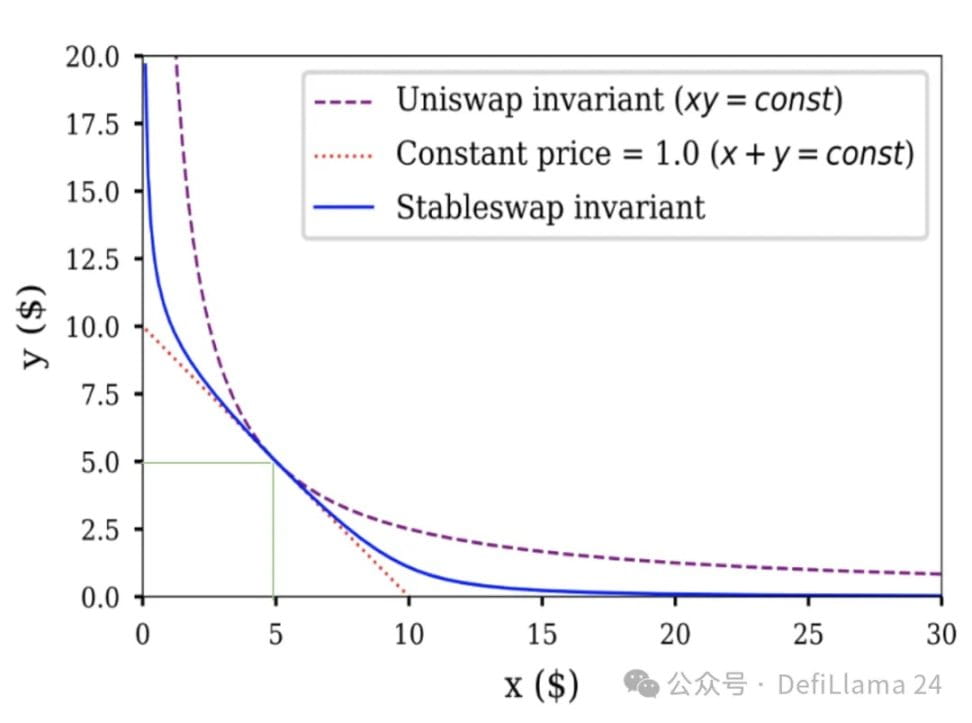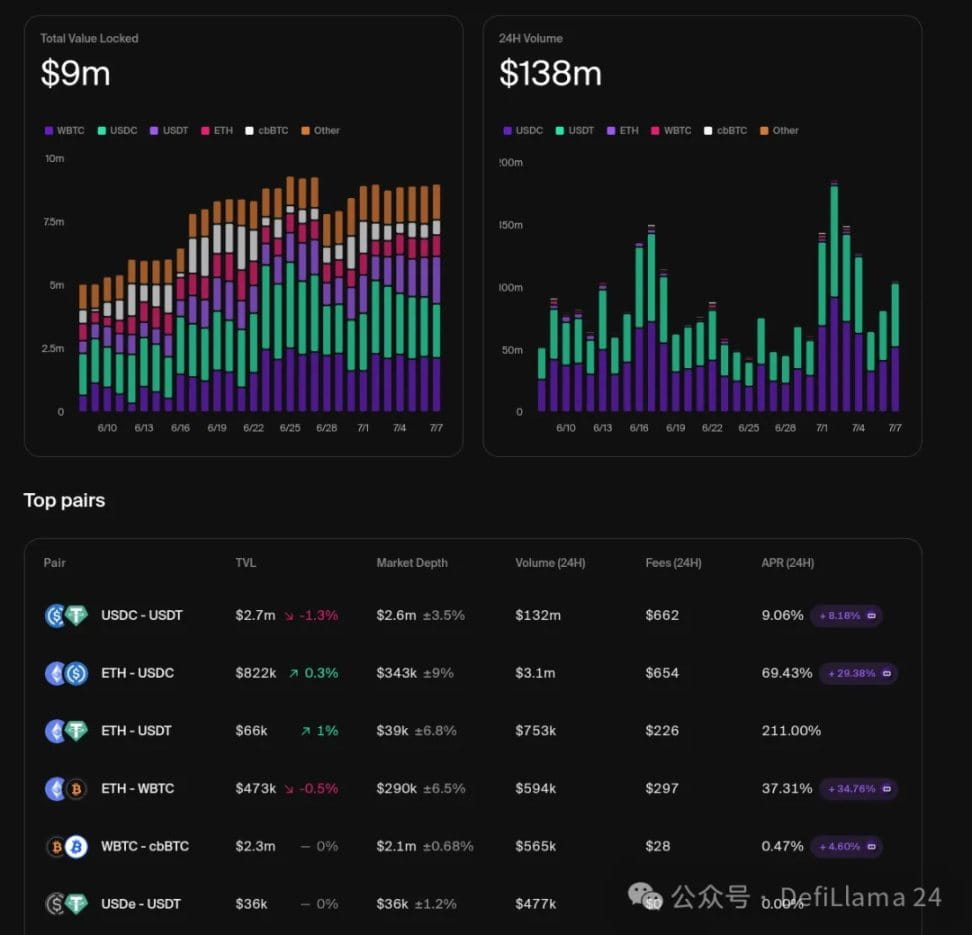Author: tokenbrice
Compiled by: LlamaC
The Early Stages of Anchored Asset Trading (2018-2019)
Once upon a time, over five years ago, the only options we had for trading on the mainnet were Uniswap, Bancor, and some cumbersome order book-based DEXs like EtherDelta. Therefore, choices for trading anchored assets at that time were extremely limited, and we could only use the USDC/USDT pool on Uniswap V2, which was a crazy move.
Let's focus on this historical anecdote to understand the extent of the waste at that time. For liquidity pools, the key parameter is the relative change in prices of the two assets: If you have participated in any volatile liquidity provision (LP), you must be very familiar with this. For example, if you provide liquidity for LINK/ETH, the maximum impermanent loss pain point is when ETH skyrockets and LINK plummets: your ETH in the LP position (price rising) will decrease, while LINK (price falling) will increase.
However, USDC/USDT is another matter; these two assets are highly correlated, and during a specific event (the USDC SVB depeg), there was a maximum price difference of about 10% between them; under normal circumstances, the price difference between the two is only within basis points. However, UNIv2 distributes liquidity across the entire price range, meaning it allocates equal amounts of liquidity anywhere between 1 USDC = 0.0000000001 USDT and 1 USDC = 10000000000000 USDT. Simply put, 99.9% of the liquidity in UNIv2_USDC/USDT will never be utilized. I believe it will be clearer on the chart:

◎ x*y=k and StableSwap
The only valuable liquidity (assuming 1 USDC ≃ 1 USDT) lies at the intersection of the two green lines, taking up a tiny fraction of the entire liquidity distribution curve.
On the other hand, please note the distribution of stablecoin trading (stableswap) liquidity shown in blue on the same chart. For assets with similar prices, the area covered by this curve is much larger than under the Uniswap invariant.
The StableSwap Revolution for Anchored Asset Trading (2020)
Once StableSwap launched, stablecoin liquidity quickly migrated there due to its significantly improved efficiency (we're talking about more than 100 times the efficiency of UNIv2). It was the first instance of concentrated liquidity on the mainnet, preceding UNIv3. The two are hard to compare directly, as UNIv3 is more flexible, while Curve-StableSwap is more focused; however, credit must be given where it is due. In addition to efficiency improvements, Curve also provided an incentive model—veCRV+CRV incentives, which have been discussed multiple times in this blog.
Incentive mechanisms are crucial for anchored asset trading pairs because they have certain specific characteristics: compared to volatile trading pairs, they generally have overall lower trading volumes. The fees LPs can collect are much lower (until recently, regular fees for volatile assets were 0.3% to 1% per trade, while for anchored assets, it was 0.05%). Their trading volumes often exhibit spikes related to events concerning the coin (for example, the USDC depeg was one of the highest trading volume days in USDC's history).
For all the reasons above, until recently, I believed that incentive mechanisms were more critical for anchored asset trading pairs than for volatile assets. However, with the emergence of Fluid DEX and EulerSwap, I no longer think so. Before delving into them, we must first review another important milestone in the history of anchored asset liquidity: the launch of Uniswap V3.
The arrival of Uniswap V3 Concentrated Liquidity (2021)
The release of Uniswap V3 provided customizable concentrated liquidity for almost all asset types, greatly enhancing the efficiency of all liquidity providers. However, since it is not only applicable to anchored assets, this also almost means that LPs for volatile assets will face higher impermanent losses. Considering the innovativeness of this liquidity structure and the lack of early infrastructure, the launch of UNIv3 initially progressed slowly.
However, this customizable concentration brings tangible benefits, especially for what I refer to as the 'loose anchored asset' subcategory: such as the following trading pairs: wstETH/ETH (related, but wstETH rises unilaterally against ETH), LUSD/USDC (related, but LUSD may be slightly above or below the pegged price).
In this case, the concentrated liquidity of UNIv3 allows LPs to replicate a distribution as efficient as Curve's Stableswap but adjusted according to the price trends of the tokens, which again brings significant efficiency improvements. However, the ultimate breakthrough (from the current industry perspective) was not achieved until the emergence of Fluid DEX and EulerSwap several years later.
Debt as liquidity (2025)
For the sake of brevity, I will not delve deeply into the models of Fluid and EulerSwap in this article, as I prefer to focus on their significance for liquidity building. Simply put, Fluid has found an innovative way to transform debt into liquidity through 'smart debt'.
Imagine a typical user providing ETH as collateral and borrowing USDC. Does he really want USDC? It’s likely that he doesn’t care as long as he borrows a safe and US dollar-pegged stablecoin. He would probably also accept USDT.
This is precisely what smart debt achieves. In a smart debt vault, borrowers are borrowing a combination of USDC and USDT, which is constantly changing: their debt now serves as liquidity for the USDC/USDT trading pair. For borrowers, this means lower borrowing costs, as they can now earn trading fees, potentially offsetting borrowing interest.
This is from the borrower's perspective, but now let's switch to the protocol's way of thinking. What does this mean for Circle and Tether? Essentially, it means almost zero-cost liquidity without any incentive mechanisms. This is not new for Circle, which has been supported by the entire ecosystem for years—but it is significant for other stablecoins like GHO, BOLD, or FRAX.
I'm mainly focusing on Fluid, but the idea is similar to EulerSwap, although the implementation is different. EulerSwap is still in testing, but it has already generated considerable trading volume on the USDC/USDT trading pair.
If you understand this, you will grasp my argument that: 'I believe there will ultimately be no anchored asset trading that is not dominated by Euler/Fluid/similar projects in the DeFi space.'
Still not clear? Please keep the following points in mind:
Anchored asset trading pairs generally have lower trading volumes ⇒ lower fees, so on traditional decentralized exchanges, they require significant incentives to maintain liquidity, which Fluid and Euler can almost sustain at zero cost.
⇒ If (it has already started) the competition for fees on anchored asset trading has entered a 'price war', then the probability of ordinary decentralized exchanges (DEX) winning is zero.
0xOrb, a potential challenger (around 2026)?
Now, to give you a comprehensive understanding of the entire anchored asset trading space, I must mention another project that has not yet launched but holds great potential: 0xOrb. Its promise is simple: stablecoin trading, but supporting n types of assets, with n up to 1000.
Taking stablecoins as an example, you can imagine a super liquidity pool with ample supplies of USDC and USDT, then gradually introducing 'alternative' stablecoins and providing excellent liquidity for trading between them and mainstream stablecoins. This approach has certain advantages for long-tail pegged assets, but I believe such liquidity pools will not dominate core trading volumes (like USDC→USDT or cbBTC→wBTC).
Additionally, these types of liquidity pools can achieve cross-chain capabilities, although I believe the benefits here are minimal, even harmful (⇒ it increases the risk and complexity of infrastructure without providing any benefits), as thanks to products like CCTP, USDC and USDT can now achieve increasingly faster 1:1 cross-chain transfers.
What does this mean for existing pure decentralized exchange (DEX) participants?
First and foremost, the most critical point: we are discussing anchored asset trading here. Replicating the same strategy on more volatile trading pairs is much more challenging, as shown by the losses suffered by Fluid's Smart Debt+Collateral ETH/USDC vault and its liquidity providers.
DEXs like Aerodrome, which primarily generate most of their trading volume and fees through volatile trading pairs, may not be significantly impacted by these new entrants. However, the reality is much harsher for DEXs focused on anchored assets; at the end of this article, I would like to discuss two of them as examples:
Curve: Game over unless a major transformation occurs
Anchored asset trading remains crucial for Curve, which is still viewed as the main venue for stablecoin liquidity. Indeed, it once tried to capture volatile trading volume through CryptoSwap but ultimately failed.
With the arrival of Fluid and EulerSwap, I believe Curve is the DEX most likely to lose market share; I don't think it will maintain significant trading volume (in fact, it has long been kicked out of the top ten) unless a major transformation occurs: veCRV Restructuring: Optimize CRV's incentive distribution by learning from new models like veAERO. Improve DEX efficiency using crvUSD: For example, by providing crvUSD loans to Curve LPs. New liquidity structures for volatile assets: So that Curve can capture relevant trading volume.
Ekubo: Overconfident latecomer hastening its own demise
Ekubo's situation can be said to be even worse, as they are recent entrants to this field. On the surface, Ekubo is a rapidly growing DEX on Ethereum with considerable trading volume. Ekubo essentially serves as a UNIv4 alternative, with more options for liquidity structure customization and a lower extraction by its DAO compared to Uniswap (although this is the lowest standard among all projects, it is still notable).
The problem lies in the source of trading volume: the vast majority (over 95%) concentrates on the USDC/USDT trading pair, with a fee of only 0.00005% and abundant incentives. Ekubo is essentially waging a price war destined to lose because it cannot sustain extremely low fees in the long term (liquidity providers need to earn), while Fluid/Euler can (if borrowers earn even 0.1% through smart debt, their situation is better than when they had no smart debt, thus they will feel satisfied).

◎ Ekubo Statistics, as of July 7, 2025
With a liquidity pool of $2.6 million TVL, processing about $130 million in trading volume daily, collecting $662 in fees per day, and incentivized by EKUBO at about 8%, they are quickly approaching the limits of their capabilities.
Interestingly, it was Ekubo itself that initiated this 'price war' with USDC/USDT trading fee rates, only to ultimately be defeated by the rules of the game it set up. DeFi will never be boring.
As always, I hope this article inspires you and deepens your understanding of the anchored asset trading game. I look forward to being 'attacked' by the Ekubo community simply for stating fact-based opinions; their reactions only make me more confident in my judgment, as I have observed the same responses in the following scenarios:
I condemned MAI's ridiculous security measures, and as a result, it was soon hacked and depegged.
I condemned R/David Garai's manipulation and lies, and less than 6 months later, R was hacked and almost disappeared.
I criticized the actions of the Prisma team, and within less than 12 months, they were hacked and the protocol was shut down.
The list goes on. Good luck to everyone.

